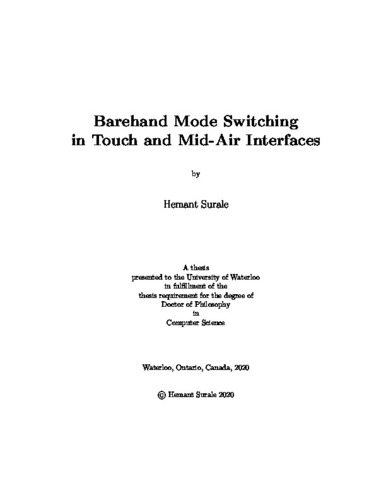UWSpace will be migrating to a new version of its software from July 29th to August 1st. UWSpace will be offline for all UW community members during this time.
Barehand Mode Switching in Touch and Mid-Air Interfaces
Abstract
Raskin defines a mode as a distinct setting within an interface where the same user input will produce results different to those it would produce in other settings. Most interfaces have multiple modes in which input is mapped to different actions, and, mode-switching is simply the transition from one mode to another. In touch interfaces, the current mode can change how a single touch is interpreted: for example, it could draw a line, pan the canvas, select a shape, or enter a command. In Virtual Reality (VR), a hand gesture-based 3D modelling application may have different modes for object creation, selection, and transformation. Depending on the mode, the movement of the hand is interpreted differently. However, one of the crucial factors determining the effectiveness of an interface is user productivity. Mode-switching time of different input techniques, either in a touch interface or in a mid-air interface, affects user productivity. Moreover, when touch and mid-air interfaces like VR are combined, making informed decisions pertaining to the mode assignment gets even more complicated. This thesis provides an empirical investigation to characterize the mode switching phenomenon in barehand touch-based and mid-air interfaces. It explores the potential of using these input spaces together for a productivity application in VR. And, it concludes with a step towards defining and evaluating the multi-faceted mode concept, its characteristics and its utility, when designing user interfaces more generally.
Collections
Cite this version of the work
Hemant Surale
(2020).
Barehand Mode Switching in Touch and Mid-Air Interfaces. UWSpace.
http://hdl.handle.net/10012/15950
Other formats
Related items
Showing items related by title, author, creator and subject.
-
Stabilization of Discrete-time Systems With Bounded Control Inputs
Jamak, Anes (University of Waterloo, 2000)In this paper we examine the stabilization of LTI discrete-time systems with control input constraints in the form of saturation nonlinearities. This kind of constraint is usually introduced to simulate the effect of ... -
A Symmetric Interaction Model for Bimanual Input
Latulipe, Celine (University of Waterloo, 2006)People use both their hands together cooperatively in many everyday activities. The modern computer interface fails to take advantage of this basic human ability, with the exception of the keyboard. However, the keyboard ... -
Litter input, soil quality and soil carbon dioxide production rates in varying riparian land uses along a first order stream in Southern Ontario, Canada.
Raimbault, Beverly Anne (University of Waterloo, 2011-08-26)Forested riparian zones, which function as a buffer between agricultural fields and streams, filter out contaminants and sediment from the fields thereby improving water quality, cool the water with shade from trees, ...

